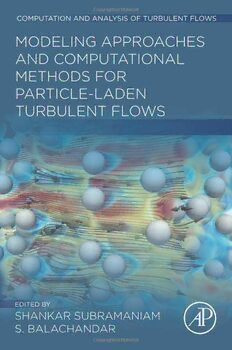
Modeling Approaches and Computational Methods for Particle-laden Turbulent Flows PDF
Preview Modeling Approaches and Computational Methods for Particle-laden Turbulent Flows
Modeling Approaches and Computational Methods for Particle-laden Turbulent Flows This page intentionally left blank Computation and Analysis of Turbulent Flows Modeling Approaches and Computational Methods for Particle-laden Turbulent Flows Edited by Shankar Subramaniam Iowa State University Department of Mechanical Engineering Ames, IA, United States S. Balachandar University of Florida Department of Mechanical and Aerospace Engineering Gainesville, FL, United States AcademicPressisanimprintofElsevier 125LondonWall,LondonEC2Y5AS,UnitedKingdom 525BStreet,Suite1650,SanDiego,CA92101,UnitedStates 50HampshireStreet,5thFloor,Cambridge,MA02139,UnitedStates TheBoulevard,LangfordLane,Kidlington,OxfordOX51GB,UnitedKingdom Copyright©2023ElsevierInc.Allrightsreserved. MATLAB®isatrademarkofTheMathWorks,Inc.andisusedwithpermission. TheMathWorksdoesnotwarranttheaccuracyofthetextorexercisesinthisbook. Thisbook’suseordiscussionofMATLAB®softwareorrelatedproductsdoesnotconstituteendorsement orsponsorshipbyTheMathWorksofaparticularpedagogicalapproachorparticularuseofthe MATLAB®software. Nopartofthispublicationmaybereproducedortransmittedinanyformorbyanymeans,electronicor mechanical,includingphotocopying,recording,oranyinformationstorageandretrievalsystem,without permissioninwritingfromthepublisher.Detailsonhowtoseekpermission,furtherinformationabout thePublisher’spermissionspoliciesandourarrangementswithorganizationssuchastheCopyright ClearanceCenterandtheCopyrightLicensingAgency,canbefoundatourwebsite: www.elsevier.com/permissions. ThisbookandtheindividualcontributionscontainedinitareprotectedundercopyrightbythePublisher (otherthanasmaybenotedherein). Notices Knowledgeandbestpracticeinthisfieldareconstantlychanging.Asnewresearchandexperience broadenourunderstanding,changesinresearchmethods,professionalpractices,ormedicaltreatment maybecomenecessary. Practitionersandresearchersmustalwaysrelyontheirownexperienceandknowledgeinevaluatingand usinganyinformation,methods,compounds,orexperimentsdescribedherein.Inusingsuch informationormethodstheyshouldbemindfuloftheirownsafetyandthesafetyofothers,including partiesforwhomtheyhaveaprofessionalresponsibility. Tothefullestextentofthelaw,neitherthePublishernortheauthors,contributors,oreditors,assume anyliabilityforanyinjuryand/ordamagetopersonsorpropertyasamatterofproductsliability, negligenceorotherwise,orfromanyuseoroperationofanymethods,products,instructions,orideas containedinthematerialherein. ISBN:978-0-323-90133-8 ForinformationonallAcademicPresspublications visitourwebsiteathttps://www.elsevier.com/books-and-journals Publisher:MatthewDeans AcquisitionsEditor:BrianGuerin EditorialProjectManager:JudithClarissePunzalan ProductionProjectManager:NirmalaArumugam CoverDesigner:MatthewLimbert TypesetbyVTeX Contents Contributors xi Abouttheeditors xv Preface xvii References xvii Acknowledgment xix 1 Introduction 1 ShankarSubramaniamandS.Balachandar 1.1 Physicaldescription 1 1.2 Scope 5 1.3 Deterministicdescriptions 7 1.4 Statisticaldescriptions 12 1.5 Importantnon-dimensionalquantities 20 1.6 Multiscalenatureofturbulentparticle-ladenflows 25 1.7 Outlineofthebook 31 Nomenclature 36 References 38 2 Particledispersionandpreferentialconcentrationinparticle-laden turbulence 43 AndrewJ.BankoandJohnK.Eaton 2.1 Introduction 43 2.2 Particledispersion 44 2.3 Preferentialconcentrationofparticlesbyturbulence 51 2.4 Turbophoresis 72 References 75 3 Physicsoftwo-waycouplinginparticle-ladenhomogeneousisotropic turbulence 81 AntoninoFerranteandSaidElghobashi 3.1 Introduction 81 3.2 Particle-ladenflowswithd <η 84 p 3.3 Particle-ladenflowswithd >η 93 p Appendix3.A Governingequations 103 Appendix3.B Equationsofconservationoflinearandangularmomenta forasolidparticlemovinginanincompressiblefluid 106 References 108 vi Contents 4 Coagulationinturbulentparticle-ladenflows 111 Lian-PingWang 4.1 Introduction 111 4.2 Geometriccollisionkernel 114 4.3 Collisionefficiency 128 4.4 Modelingtheevolutionofparticlesizedistribution 131 4.5 Aspecificapplication:turbulentcollisioncoalescenceofcloud dropletsanditsimpactonwarmrainprecipitation 135 4.6 Summaryandoutlook 138 Acknowledgments 140 References 140 5 Efficientmethodsforparticle-resolveddirectnumericalsimulation 147 MarkusUhlmann,JosDerksen,AnthonyWachs,Lian-PingWang,and ManuelMoriche 5.1 Introduction 147 5.2 TheimmersedboundarymethodinNavier–Stokes-basedsolvers 149 5.3 DistributedLagrangemultipliermethods 157 5.4 Boltzmannequation-basedmesoscopicmethods 160 5.5 Referencedatasets 174 5.6 ComparingPR-DNSmethods:adifficultexercise 176 5.7 Conclusionandoutlook 177 Acknowledgment 178 References 178 6 Resultsfromparticle-resolvedsimulations 185 AgatheChouippe,AmanG.Kidanemariam,JosDerksen, AnthonyWachs,andMarkusUhlmann 6.1 Introduction 185 6.2 PR-DNSofdensefluidizedsystemsfordragforce parameterizationsbasedondynamicsimulations 186 6.3 PR-DNSofunboundedflowsinthediluteregime 192 6.4 PR-DNSofwall-boundedshearflows 199 6.5 Conclusionsandoutlook 208 References 209 7 Modelingofshort-rangeinteractionsbetweenbothsphericaland non-sphericalrigidparticles 217 AnthonyWachs,MarkusUhlmann,JosDerksen,andDamienP.Huet 7.1 Introduction 218 7.2 Motionofanon-sphericalrigidbody 220 7.3 Geometricdescriptionofanon-sphericalrigidbodyandthe problemofcollisiondetectionofnon-sphericalrigidbodies 223 7.4 Non-collisionalshort-rangehydrodynamicinteractions:lubrication indiluteregime 229 Contents vii 7.5 MethodsforLagrangiantrackingofnon-sphericalrigidbodieswith collisions 231 7.6 Efficientandparallelimplementationofgranulardynamicssolvers andtheirparallelcouplingtothefluidsolver 246 7.7 Testcases 250 7.8 Outlook 254 References 255 8 ImprovedforcemodelsforEuler–Lagrangecomputations 265 JeremyA.K.Horwitz 8.1 Introduction 265 8.2 Undisturbedquantities 268 8.3 StochasticeffectsinEuler–Lagrangesimulationforunresolved fields 271 8.4 FluidequationsfordiluteflowsmodeledwiththeEuler–Lagrange method 273 8.5 Particleequationofmotion 273 8.6 Eulerian–Lagrangiandatatransfer 282 8.7 Correctionschemesfortheundisturbedquantities 284 8.8 Summaryandfuturedirections 292 8.9 Discussionquestions 292 Acknowledgments 293 References 293 9 Deterministicextendedpoint-particlemodels 299 S.BalachandarandMartinR.Maxey 9.1 Motivationtogobeyondthepoint-particlemodel 299 9.2 Neighborinfluence 301 9.3 Undisturbedflowprediction 303 9.4 DeterministicparticleforcepredictionusingthePIEPmodel 307 9.5 Beyondpairwiseapproximationusingmachinelearning 312 9.6 Conceptandstatementoftheforcecouplingmethod 315 9.7 FCMresultsforindividualparticles 318 9.8 ExamplesofFCMapplications 324 9.9 Comments 325 References 327 10 Stochasticmodels 331 AaronM.LattanziandShankarSubramaniam 10.1 Motivationforstochasticmodels 332 10.2 Dispersionofinertialparticlesfromapointsource 334 10.3 Lagrangianparticledescription 341 10.4 Challengesinmodelingturbulentparticle-ladenflow 354 10.5 Modelsforinertialparticlesinturbulence 355 viii Contents 10.6 Numericalconsiderations 368 10.7 Summaryandextensions 372 Appendix10.A DetailsofnumericalintegrationofSDEs 373 Appendix10.B Fastandslowvariables 375 References 377 11 Volume-filteredEuler–Lagrangemethodforstronglycoupled fluid–particleflows 383 JesseCapecelatroandOlivierDesjardins 11.1 Stronglycoupledfluid–particleflows 383 11.2 Microscaledescription 385 11.3 Volume-filtering 387 11.4 Closuremodeling 394 11.5 Numericalimplementation 397 11.6 Applicationtothestudyofstronglycoupledparticle-ladenflows 403 11.7 Extensions 408 11.8 Concludingremarks 413 References 414 12 Quadrature-basedmomentmethodsforparticle-ladenflows 419 AlbertoPassalacquaandRodneyO.Fox 12.1 Introduction 419 12.2 Thekineticequationanditsgeneralization 422 12.3 Generalitiesonmomentmethods 427 12.4 Quadrature-basedmomentclosures 431 12.5 AnisotropicGaussianclosureformonodisperseflows 437 12.6 AnisotropicGaussianclosureforpolydisperseflows 442 12.7 Closure 444 References 444 13 Eulerian–Eulerianmodelingapproachforturbulentparticle-laden flows 449 BerendvanWachem 13.1 Introduction 449 13.2 DerivationoftheEulerian–Eulerianmodelforfluid–solidflows 452 13.3 Probabilitydensityfunction 457 13.4 Closurerelations 467 13.5 Outlookandconclusions 479 References 480 14 Multiscalemodelingofgas-fluidizedbeds 483 YaliTangandJ.A.M.(Hans)Kuipers 14.1 Introduction 483 14.2 Multiscalemodeling 492 Contents ix 14.3 Outlook 519 Acknowledgment 522 References 522 15 Futuredirections 537 ShankarSubramaniamandS.Balachandar 15.1 Futuredirections 537 15.2 Mappingthehigh-dimensionalparameterspace 538 15.3 Discoveryandquantificationofflowphysics 540 15.4 Theoreticalchallenges 541 15.5 Modelingneeds 542 15.6 Needforcollaborativeefforts 546 References 546 Index 549
